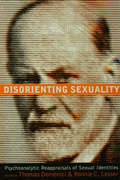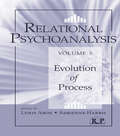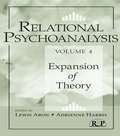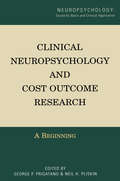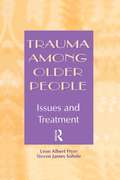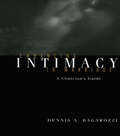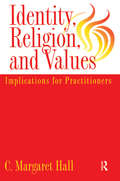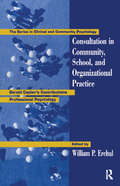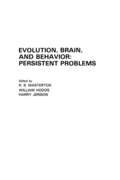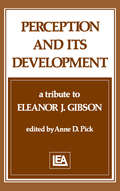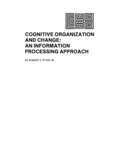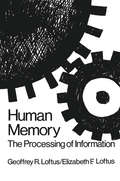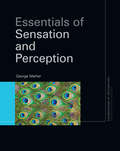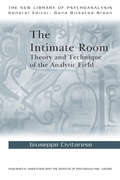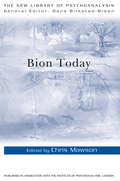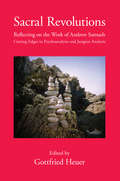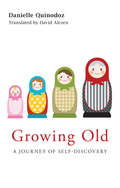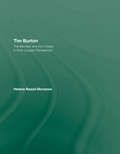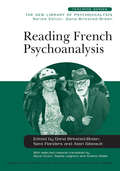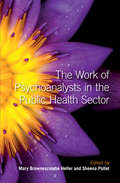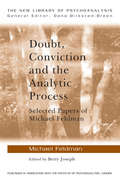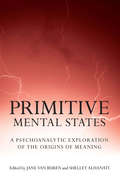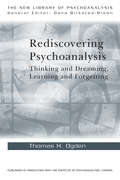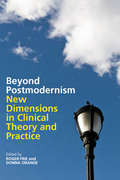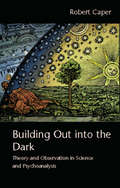- Table View
- List View
Disorienting Sexuality: Psychoanalytic Reappraisals of Sexual Identities
by Thomas Domenici Ronnie C. LesserDisorienting Sexuality exposes the biases against gay men and lesbians in psychoanalytic theory and practice. In the introduction, Domenici and Lesser draw a brief history of anti-homosexual sentiment in psychoanalysis. The book then moves into essays written by lesbian and gay psychoanalysts seeking to have a voice in the reshaping of psychoanalytic theories of sexuality. The second section is devoted to presenting different theoretical perspectives for understanding both homosexuality and heterosexuality. Disorienting Sexuality concludes with the personal narratives of gay and lesbian psychoanalysts.
Relational Psychoanalysis, Volume 5: Evolution of Process (Relational Perspectives Book Series #14)
by Lewis Aron Adrienne HarrisBuilding on the success and importance of three previous volumes, Relational Psychoanalysis continues to expand and develop the relational turn. Under the keen editorship of Lewis Aron and Adrienne Harris, and comprised of the contributions of many of the leading voices in the relational world, Volume 5 carries on the legacy of this rich and diversified psychoanalytic approach by taking a fresh look at the progress in therapeutic process. Included here are chapters on transference and countertransference, engagement, dissociation and self-states, analytic impasses, privacy and disclosure, enactments, improvisation, development, and more. Thoughtful, capacious, and integrative, this new volume places the leading edge of relational thought close at hand, and pushes the boundaries of the relational turn that much closer to the horizon. Contributors: Lewis Aron, Anthony Bass, Beatrice Beebe, Philip Bromberg, Steven Cooper, Jody Messler Davies, Darlene Ehrenberg, Dianne Elise, Glen Gabbard, Adrienne Harris, Irwin Hoffman, Steven Knoblauch, Thomas Ogden, Spyros Orfanos, Stuart Pizer, Philip Ringstrom, Jill Salberg, Stephen Seligman, Joyce Slochower, Donnel Stern, Paul Wachtel.
Relational Psychoanalysis, Volume 4: Expansion of Theory (Relational Perspectives Book Series #14)
by Adrienne Harris Lewis AronBuilding on the success and importance of three previous volumes, Relational Psychoanalysis continues to expand and develop the relational turn. Under the keen editorship of Lewis Aron and Adrienne Harris, and comprised of the contributions of many of the leading voices in the relational world, Volume 4 carries on the legacy of this rich and diversified psychoanalytic approach by taking a fresh look at recent developments in relational theory. Included here are chapters on sexuality and gender, race and class, identity and self, thirdness, the transitional subject, the body, and more. Thoughtful, capacious, and integrative, this new volume places the leading edge of relational thought close at hand, and pushes the boundaries of the relational turn that much closer to the horizon. Contributors: Neil Altman, Jessica Benjamin, Emanuel Berman, Jeanne Wolff Bernstein, Susan Coates, Ken Corbett, Muriel Dimen, Martin Stephen Frommer, Jill Gentile, Samuel Gerson, Virginia Goldner, Sue Grand, Hazel Ipp, Kimberlyn Leary, Jonathan Slavin, Malcolm Owen Slavin, Charles Spezzano, Ruth Stein, Melanie Suchet.
Clinical Neuropsychology and Cost Outcome Research: A Beginning
by George P. Prigatano Neil H. PliskinNeuropsychologists are being increasingly called upon to demonstrate the value of their services. This edited book introduces clinical neuropsychologists to the concepts and challenges involved in conducting cost outcome research. It provides examples of how such research can be conducted within clinical neuropsychology and therefore is a "beginning" step in what must become an interdisciplinary effort. The text suggests that more than cost effectiveness studies should be considered when demonstrating the clinical utility of neuropsychological services. The concept of "objective" and "subjective" markers of value is emphasized, particularly as it relates to measuring the impact of a neuropsychological examination. Chapters review the economic burdens associated with different neurological conditions commonly seen by neuropsychologists. They also provide examples of how clinical neuropsychological services to different patient populations may reduce "costs" and increase "benefits" and suggest directions for beginning cost outcome research. Furthermore, the book summarizes the utility of various neuropsychological services that may be helpful to readers concerned with healthcare economies. The book is intended as a resource for clinical neuropsychologists who wish to explain to healthcare providers the value of their work. It is the first book of the National Academy of Neuropsychology book series entitled: Neuropsychology: Scientific Bases and Clinical Application.
Trauma Among Older People: Issues and Treatment
by Leon Albert Hyer Steven SohnleTrauma Among Older Adults presents an integrative model of treatment that considers current theories of treatment in light of special considerations relating to elderly patients. The book provides case studies, vignettes, and discussions, and demonstrates the importance of considering the personality, memory, and familial history of an elderly individual who has suffered a trauma.
Enhancing Intimacy in Marriage: A Clinician's Guide
by Dennis A. BagarozziMost people believe that intimacy is a unitary construct-that is, that it is made up of only one component. Dr. Bagarozzi demonstrates how intimacy is comprised of at least nine separate subcomponents. The degree to which partners can meet the intimacy needs of their mates in all nine areas is critical to marital satisfaction. Building upon the foundations of the author's Enhancing Intimacy Program, which he developed and utilized in his own practice with clients, Enhancing Intimacy in Marriage explores the ways in which intimacy is demonstrated and communicated between married partners. A simple questionnaire, the Intimacy Needs Survey, is used to help couples identify areas of satisfaction and areas where intimacy needs are not being met. Clinical strategies for helping couples improve their intimacy are presented in case examples. This book is unique in that it offers clinicians a step-by-step approach for both assessment and intervention
Identity Religion And Values: Implications for Practitioners
by C. Margaret HallDesigned for professionals, this handbook focuses on the impact of patients' religion snd spirituality. It presents the identity empowerment theory, a clinical sociological theory, and includes case studies and intervention strategies.
Consultation In Community, School, And Organizational Practice: Gerald Caplan's Contributions To Professional Psychology (Clinical and Community Psychology)
by William P. ErchulOffering an historical perspective on the development of mental health consultation and community mental health, this book's intent is twofold. First, it describes and evaluates Harvard psychiatrist Gerald Caplan's innovative approach to consultation and related activities with respect to the current and future practice of clinical community, school and organizational psychology. Second, it pays tribute to Caplan whose ideas on prevention, crisis theory, support systems, community mental health, mental health consultation and collaboration and population-orientated psychiatry have influenced the practice of professional psychology and allied fields.; The text is divided into three sections: the first provides background information for the remainder of the volume; the second documents Caplan's influence on the way psychology has been applied in various settings; andthe last considers his contribution's present and past influence. The text is aimed at consultant and practising psychologists, community and school psychology graduates and professionals involved with community mental health services.
Evolution, Brain, and Behavior: Persistent Problems
by R. B. MASTERTON, WILLIAM HODOS AND HARRY JERISONIn this second volume on the evolution of the nervous system and behavior, the discussion turns from conclusions to method, from a desciption of what happened in history to the means of deciidng what happened. First published in 1976.
Perception and Its Development: A Tribute To Eleanor J. Gibson
by Anne D. PickWe have acquired important new knowledge about the nature and development of perception in recent years, and the insights of Eleanor Jack Gibson have had a prominent role in guiding the search for that knowledge. The purpose of this volume is to honor her continuing conrbution to our understanding of perception. First published in 1979. Routledge is an imprint of Taylor & Francis, an informa company.
Cognitive Organization and Change: An Information-processing Approach (Complex Human Behavior Ser.)
by R. S. Wyer, Jr.This book grew out of a graduate course in cognitive organization and change that the author taught during his tenure at the University of Illinois at Chicago Circle. Two primary objectives of the course are reflected in this book: first, to provide a general conceptual framework for critically and systematically analyzing research and theory on attitude and opinion change; second, to stimulate research on fundamental problems, related to these phenomena, that are made salient as a result of this analysis. First published in 1974. Routledge is an imprint of Taylor & Francis, an informa company.
Human Memory: The Processing of Information
by Geoffrey R. Loftus Elizabeth F. LoftusOver the past 20 years, the study of human memory has become an increasingly popular topic of study for psychologists, and since the late 1960s a new framework for studying memory has begun to take shape. It is the purpose of this book to present a broad overview of this framework, including descriptions of (1) the major theoretical components of the framework and (2) the critical research findings that justify the establishment of these components and illuminate the mechanisms by which they operate. The book is not meant to constitute an exhaustive review of the enormous research literature that has accrued over the years. The authors deliberately avoid wading into masses of detail on any given topic area, and we deliberately sidestep a number of current theoretical controversies. Instead, this book has been planned to be a guide and an introduction for the student or interested layman with little or no background in the area of memory as a field of psychological inquiry.
Essentials of Sensation and Perception (Foundations of Psychology)
by George MatherThe study of sensation and perception looks at how we acquire, process, and interpret information about the outside world. By describing key ideas from first principles, this straightforward introduction provides easy access to the basic concepts in the subject, and incorporates the most recent advances with useful historical background. The text takes a uniquely integrative approach, highlighting fundamental findings that apply across all the senses - including vision, hearing, touch, pain, balance, smell and taste - rather than considering each sense in isolation. Several pedagogical features help students to engage with the material. ‘Key Term’ and ‘Key Concept’ boxes describe technical terms and concepts whilst ‘Question’ boxes relate the material to everyday questions about perception. Each chapter ends with suggestions for further reading, and the final chapter draws together the material from the previous chapters, summarizing the broad principles described, and outlining some major unresolved issues. Assuming no prior knowledge, this book is an accessible and up-to-date overview of the processes of human sensation and perception. Presented in full color, it is an ideal introduction for pre-undergraduate and first year undergraduate students on courses in psychology, as well as neuroscience and biology.
The Intimate Room: Theory and Technique of the Analytic Field (New Library of Psychoanalysis)
by Giuseppe CivitareseThe Intimate Room provides an original exploration of psychoanalytic thought, showing how contemporary psychoanalysis seeks to answer the challenges raised by today’s post-modern culture. Offering a deeply personal and insightful reading of Bion, this book acts as a stimulating guide to the development of the theory of the analytic field and both its technical and clinical implications. As such topics of discussion include: the concept of the internal setting the rhetoric of interpretation the 'subversive' notion of Nachträglichkeit the role played by characters in analytic discourse the bi-personal field as virtual reality new concepts of transference. Allowing the reader to engage with the inner space of analysis, The Intimate Room will be of interest to psychoanalysts, psychotherapists and all those with an interest in the field of psychoanalysis. It will also be a useful tool in psychoanalytic and psychotherapeutic work on a day-to-day basis.
Bion Today: Bion Today (The New Library of Psychoanalysis)
by Chris MawsonBion Today explores how Bion’s work is used in contemporary settings; how his ideas have been applied at the level of the individual, the group and the organisation; and which phenomena have been made more comprehensible through the lenses of his concepts. The book introduces distinctive psychoanalytic contributions to show the ways in which distinguished analysts have explored and developed the ideas of Wilfred Bion. Drawing on the contributors’ experience of using Bion’s ideas in clinical work, topics include: an introduction to Bion clarification of the inter-related concepts of countertransference and enactment concepts integrating group and individual phenomena clinical implications of Bion’s thought Bion’s approach to psychoanalysis. Bion Today will be a valuable resource for psychoanalysts, psychotherapists and all those who are interested in learning more about Bion’s thinking and his work.
Sacral Revolutions: Reflecting on the Work of Andrew Samuels – Cutting Edges in Psychoanalysis and Jungian Analysis
by Gottfried HeuerSacral Revolutions is a unique project reflecting the contribution that Andrew Samuels has made to the general field of psychoanalysis and Jungian analysis in both clinical and academic contexts. Gottfried Heuer has brought together an international array of authors – friends and colleagues of Samuels – to honour his 60th Birthday. As a result, the collection provides a creative and cutting-edge overview of a fragmented field. The chapters demonstrate the profound sense of social responsibility of these analysts and academics whose concerns include the mysteries and hidden meanings in social and political life. This open and engaging volume includes a previously unpublished interview with C. G. Jung, adding to its usefulness as an essential companion for academics, analysts, therapists and students.
Growing Old: A Journey of Self-Discovery
by Danielle QuinodozPeople react very differently to the process of ageing. Some people shy away from old age for as long as they can and eventually spend it reflecting on times when they were physically and mentally stronger and more independent. For others old age is embraced as a new adventure and something to look forward to. In this book psychoanalyst Danielle Quinodoz highlights the value of old age and the fact that although many elderly people have suffered losses, either of their own good health or through bereavement, most have managed to retain the most important thing – their sense of self. Quinodoz argues that growing old provides us with the opportunity to learn more about ourselves and instead of facing it with dread, it should be celebrated. Divided into accessible chapters this book covers topics including: the internal life-history remembering phases of life anxiety about death being a psychoanalyst and growing old. Throughout Growing Old the author draws on both her clinical experience of working with the elderly, and her own personal experience of growing old. This makes it an interesting read for both practising psychoanalysts, and those who wish to gain a greater insight of the natural progression into later life.
Tim Burton: A Post-Jungian Perspective
by Helena Bassil-MorozowTim Burton’s films are well known for being complex and emotionally powerful. In this book, Helena Bassil-Morozow employs Jungian and post-Jungian concepts of unconscious mental processes along with film semiotics, analysis of narrative devices and cinematic history, to explore the reworking of myth and fairytale in Burton’s gothic fantasy world. The book explores the idea that Burton’s lonely, rebellious ‘monstrous’ protagonists roam the earth because they are unable to fit into the normalising tendencies of society and become part of ‘the crowd’. Divided into six chapters the book considers the concept of the archetype in various settings focusing on: the child the monster the superhero the genius the maniac the monstrous society. Tim Burton: The Monster and the Crowd offers an entirely fresh perspective on Tim Burton’s works. The book is essential reading for students and scholars of film or Jungian psychology, as well as anyone interested in critical issues in contemporary culture. It will also be of great help to those fans of Tim Burton who have been searching for a profound academic analysis of his works.
Reading French Psychoanalysis (New Library of Psychoanalysis Teaching Series)
by David Alcorn Alain Gibeault Dana Birksted—Breen Sara Flanders Sophie Leighton Andrew WellerHow has psychoanalysis developed in France in the years since Lacan so dramatically polarized the field? In this book, Dana Birksted-Breen and Sara Flanders of the British Psychoanalytical Society, and Alain Gibeault of the Paris Psychoanalytical Society provide an overview of how French psychoanalysis has developed since Lacan. Focusing primarily on the work of psychoanalysts from the French Psychoanalytical Association and from the Paris Psychoanalytical Society, the two British psychoanalysts view the evolution of theory as it appears to them from the outside, while the French psychoanalyst explains and elaborates from inside the French psychoanalytic discourse. Seminal and representative papers have been chosen to illuminate what is special about French thinking. A substantial general introduction argues in favour of the specificity of 'French psychoanalysis', tracing its early influences and highlighting specific contemporary developments. Sections are made up of introductory material by Alain Gibeault, followed by illustrative papers in the following categories: the history of psychoanalysis in France the pioneers and their legacy the setting and the process of psychoanalysis phantasy and representation the body and the drives masculine and feminine sexuality psychosis. An excellent introduction to French psychoanalytical debate, Reading French Psychoanalysis sheds a complementary light on thinking that has evolved differently in England and North America. It will be ideal reading for beginners and advanced students of clinical theory as well as experienced psychoanalysts wanting to know more about French Psychoanalytic theory, and how it has developed.
The Work of Psychoanalysts in the Public Health Sector
by Sheena Pollet Mary HellerThis book provides a comprehensive insight into the ways in which psychoanalysts think and work. Mary Brownescombe Heller and Sheena Pollet bring together internationally known contributors trained at the Institute of Psychoanalysis to explore the broad range of clinical work, thinking, and teaching undertaken with children, families, adults and staff by psychoanalysts in the UK public health sector. Divided into four sections, The Work of Psychoanalysts in the Public Health Sector covers: clinical work with parents and young children, clinical work with adults and their families, analytic thinking in health service practice analytic support for health service staff. Experienced psychoanalysts discuss work with various client groups including parents with babies, children, adolescents who self harm, and adults with serious mental health conditions and psychosis. The book also explores how psychoanalytically-informed work can be used alongside other treatment methods, and how health service staff can best be trained and supported. The Work of Psychoanalysts in the Public Health Sector offers the reader a broad perspective and a clear understanding of the various analytical concepts used in clinical practice. It will be invaluable reading for anyone interested in, or already using psychoanalytic ideas and techniques in the health sector, as well as students in training.
Doubt, Conviction and the Analytic Process: Selected Papers of Michael Feldman (The New Library of Psychoanalysis)
by Michael FeldmanIn this profound and subtle study, a practising psychoanalyst explores the dynamics of the interaction between the patient and the analyst. Michael Feldman draws the reader into experiencing how the clinical interaction unfolds within a session. In doing so, he develops some of the implications of the important pioneering work of such analysts as Klein, Rosenfeld and Joseph, showing in fine detail some of the ways in which the patient feels driven to communicate to the analyst, not only in order to be understood by him, but also in order to affect him. The author's detailed descriptions of the clinical process allow the reader to follow the actual process that enables the patient to get into contact with thoughts and feelings of which he or she was previously unconscious or only vaguely aware. Feldman makes the reader aware of the constant dynamic interaction between the patient and the analyst, each affecting the other. He shows how the analyst has to find a balance between doubt, uncertainty and confusion in himself and through this process may arrive at an understanding of what is happening, and by formulating this understanding the analyst can make a significant contribution to the process of psychic change. This collection of essays not only throws light on fascinating questions of technique, but also reflects on elements that are fundamental to psychoanalytic work. It is essential reading for practising psychoanalysts and those in training, as well as anyone with a general interest in the psychoanalytic relationship between the client and the therapist in the consulting room.
Primitive Mental States: A Psychoanalytic Exploration of the Origins of Meaning (Primitive Mental States Ser. #Vol. I)
by Jane Van Buren Shelley AlhanatiTraditional psychoanalysis relies on the presence of certain meaning-making capacities in the patient for its effectiveness. Primitive Mental States examines how particular capacities including those for symbolising, fantasising, dreaming, experiencing and finding meanings in those experiences, can be taken for granted. Many of us lack these capacities in certain dimensions of our minds making traditional psychoanalysis ineffective. In this book, international contributors are brought together to consider a radical evolution in contemporary psychoanalytic theory developed from a combination of ultrasound studies, infant analysis, and observation of mothers and babies. These findings demonstrate how much mental life exists even before birth and considers unevolved, unborn and barely born aspects of the self such as the birth of emotion and the birth of alpha functioning. Topics covered include: prenatal imprints on the mind and body difficult to treat patients non-verbal, non-symbolic, disembodied states of being early relational and attachment trauma. Illustrated throughout with original data and extensive clinical discussions from some of the biggest names in the field, Primitive Mental States will be a useful resource for students and seasoned analysts alike.
Rediscovering Psychoanalysis: Thinking and Dreaming, Learning and Forgetting (The New Library of Psychoanalysis)
by Thomas H. OgdenWinner of the 2010 Haskell Norman Prize for Outstanding Achievement in Psychoanalysis! Rediscovering Psychoanalysis demonstrates how, by attending to one’s own idiosyncratic ways of thinking, feeling, and responding to patients, the psychoanalyst can develop a "style" of his or her own, a way of practicing that is a living process originating, to a large degree, from the personality and experience of the analyst. This book approaches rediscovering psychoanalysis from four vantage points derived from the author’s experience as a clinician, a supervisor, a teacher, and a reader of psychoanalysis. Thomas Ogden begins by presenting his experience of creating psychoanalysis freshly in the form of "talking-as-dreaming" in the analytic session; this is followed by an exploration of supervising and teaching psychoanalysis in a way that is distinctly one’s own and unique to each supervisee and seminar group. Ogden goes on to rediscover psychoanalysis in this book as he continues his series of close readings of seminal analytic works. Here, he makes original theoretical contributions through the exploration, explication, and extension of the work of Bion, Loewald, and Searles. Throughout this text, Thomas Ogden offers ways of revitalizing and reinventing the exchange between analyst and patient in each session, making this book essential reading for psychoanalysts, psychotherapists, and other readers with an interest in psychoanalysis.
Beyond Postmodernism: New Dimensions in Clinical Theory and Practice
by Donna Orange Roger FrieBeyond Postmodernism identifies ways in which psychoanalysis has moved beyond the postmodern debate and discusses how this can be applied to contemporary practice. Roger Frie and Donna Orange bring together many of the leading authorities on psychoanalytic theory and practice to provide a broad scope of psychoanalytic viewpoints and perspectives on the growing interdisciplinary discourse between psychoanalysis, continental philosophy, social theory and philosophy of mind. Divided into two parts, Psychoanalytic Encounters with Postmodernism and Psychoanalysis Beyond Postmodernism, this book: elaborates and clarifies aspects of the postmodern turn in psychoanalysis furthers an interdisciplinary perspective on clinical theory and practice contributes to new understandings of theory and practice beyond postmodernism. Beyond Postmodernism: New Dimensions in Clinical Theory and Practice provides a fresh perspective on the relationship between psychoanalysis and postmodernism and raises new issues for the future. It will be of interest to practicing psychoanalysts and psychologists as well as students interested in psychoanalysis, postmodernism and philosophy.
Building Out into the Dark: Theory and Observation in Science and Psychoanalysis
by Robert CaperIn this book, Robert Caper provides the reader with an introduction to psychoanalysis focusing explicitly on whether psychoanalysis is part of the sciences, and if not, where it belongs. Many psychoanalysts, beginning with Freud, have considered their discipline a science. In this book, Caper examines this claim and investigates the relationship of theory to observation in both philosophy and the experimental sciences and explores how these observations differ from those made in psychoanalytic interpretation. Building Out into the Dark also explores topics including: the origins of psychoanalysis in the art of medicine the therapeutic effect of psychoanalysis the archaic superego psychoanalysis with the individual and groups what makes psychoanalytic work unique. Building Out into the Dark offers a thoughtful consideration of the nature of psychoanalytic knowledge and how it is gained. The book's accessible and concise style makes it a useful introductory resource for students studying psychoanalysis, for psychotherapists who are curious about the distinction between psychoanalysis and other forms of therapy as well as those interested in placing psychoanalysis in the context of current cultural and intellectual developments.
